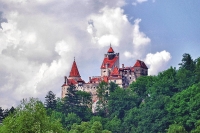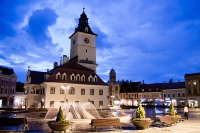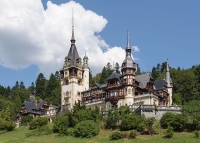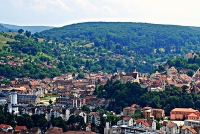
Often referred to as Dracula's Castle, the fortified medieval Bran Castle is a national monument and landmark of Romania. Looking exactly as a vampire count's abode should, the forbidding façade, towers, and ramparts rise out of the forest, perched high on a steep cliff face against a dramatic mountain background. Despite its aesthetic, there is little evidence to suggest Vlad Tepes, the speculated inspiration for Dracula, ever stayed there.Bran Castle was built in 1377 to protect nearby Brasov from invaders, later becoming the favourite summer residence of Queen Marie, offered to her by the people of Brasov. The rooms and towers surround an inner courtyard with a sculpted stone fountain. A warren of narrow, winding stairs, secret chambers, and underground passageways lead between vaulted halls, a prison, a living area, and watchtowers with sweeping views.The rooms are decorated with a collection of Baroque furniture, elaborately carved four-poster beds, weapons and armour dating from the 14th to 19th centuries. On the grounds below is an open-air ethnographic Village Museum consisting of old local-style architecture with household objects, costumes, and furniture on display. At the entrance to the castle grounds is a large handicraft market to entice tourists with souvenirs from the fantastical castle.
Address : Strada General Traian Moșoiu 24, Bran
E-mail : [email protected]
Website : www.bran-castle.com
Telephone : +4 0268 237 700
Opening times : Tuesday to Sunday 9am-4pm, Monday 12pm-4pm.
Admission : 40 Lei adults, 10 Lei children, other concessions available.

Nestled at the foot of Mount Tâmpa, is the charming medieval town of Brasov, one of the seven fortified towns settled by the Saxons, with a distinct Germanic flavour to its history and culture. The Saxons built massive stone walls and seven bastions around the city that are still visible today, as well as ornate churches, elaborately trimmed buildings, and a fine central square that is said to be where the legendary Pied Piper led the children of Hamlin.Lining the square are the red-roofed merchant's houses, now occupied by cafes and shops surrounding the 15th-century Old Town Hall, home to the History Museum. The town's landmark is the impressive Gothic structure known as the Black Church, so named because a fire blackened its outer walls in 1689. The interior represents the quintessential East European church, with balconies, stained glass windows, an enormous organ, stone columns, and walls adorned with fabulous Turkish carpets. Many people use Brasov as a base for visiting the nearby attractions of Dracula's Castle at Bran, as well as Râsnov Castle and the ski resorts of Sinaia and Poiana Brasov.
Website : www.brasov.ro

The quintessential fairy tale castle, complete with turrets and surrounded by forests, the neo-classical Peles Castle was the summer residence for Romania's kings. Built by King Carol I in 1883, the castle is a masterpiece of German-Renaissance architecture with an exquisite exterior, and emerges from fir forests and the towering peaks of the Carpathian range.The castle's 160 rooms are magnificent; lavishly decorated in ebony, mother of pearl, walnut, and leather with crystal chandeliers, fine collections of sculptures, paintings and tapestries, and stained glass windows and furniture. It is set within a large park with a statue garden in front. Further up the hill from the main palace is the smaller Pelisor Palace, built for Carol I's son and decorated in the Art Nouveau style.
Address : Aleea Peleșului 2
Website : www.peles.ro
Opening times : Wednesday to Sunday 9.15am-5pm, closed Monday and Tuesday/
Admission : 30 lei Adults, free for children, other concession available.

Sighisoara is a beautifully preserved medieval town, renowned as the birthplace of 'Dracula', or Vlad the Impaler. It is also a UNESCO World Heritage Site and one of the seven fortified towns founded by the Saxons in the hills of Transylvania. The hilltop citadel dominates the town with the original medieval settlement enclosed within the fortress walls, surrounded by nine surviving towers.Within the old town, the narrow cobbled streets and steep alleyways, brightly-painted, lopsided houses, ancient churches, stone archways, and covered stairways are watched over by the striking Clock Tower, the control tower of the main gate with magnificent views over the whole town and countryside. At the foot of the Clock Tower is the simple yellow building where Vlad was born and lived with his father, Vlad Dracul, and is marked by a hanging wrought-iron dragon. It now houses a restaurant with medieval furnishings.The ancient cobblestone street that passes beneath the Clock Tower leads to the lower town, and although shabbier than the citadel, it has some interesting little shops where 'Vampire Wine' and locally made products can be bought. There are also lively markets here and pretty stone squares where townsfolk gather to chat animatedly about daily affairs. Every year in July the town is host to the Sighisoara Medieval Festival, one of Romania's biggest and most popular festivals.

Travel Guide powered by Word Travels, copyright © 2023 Globe Media Ltd. By its very nature information in this travel guide is subject to change at short notice and travellers are urged to verify information on which they're relying with the relevant authorities. Neither Globe Media Ltd nor Travel Vogue can accept any responsibility for any loss or inconvenience to any person as a result of information contained above.